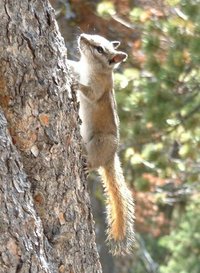Chipmunk
|
|
- This article is about the animal. For the military training aircraft, see De Havilland Chipmunk.
| Chipmunks | ||||||||||||
|---|---|---|---|---|---|---|---|---|---|---|---|---|
 | ||||||||||||
| Scientific classification | ||||||||||||
| ||||||||||||
| Species | ||||||||||||
|
Genus: Tamias
|
Chipmunk is the common name for any small squirrel-like rodent species of the genus Tamias in the family Sciuridae. About twenty-five species fall under this title, mostly native to North America, with one species in northeastern Asia. The common species of the eastern United States is the Eastern Chipmunk Tamias striatus, with several species in different parts of the western US.
The name stems from the loud chip sound that they make, in addition to a rapid trill sound. They are also called striped squirrel or ground squirrel; however, the name "ground squirrel" is more usually kept for the genus Spermophilus, though Tamias and Spermophilus are only two of the 13 genera of ground-living sciurids.
Though they are commonly depicted with their paws up to the mouth, eating peanuts, or more famously their cheeks bulging out on either side, chipmunks eat a much more diverse range of foods than just nuts. Their omnivorous diet consists of grain, nuts, birds' eggs, and insects. Come autumn, many species of chipmunk begin to stockpile these goods in their burrows, for winter. Other species make multiple small caches of food. These two kinds of behavior are called larder hoarding and scatter hoarding. Larder hoarders usually live in their nests until spring.
Chipmunks construct expansive burrows which can be more than 3.5 m in length with several well-concealed entrances. The sleeping quarters are kept extremely clean as shells and feces are stored in refuse tunnels.
If unmolested they often become bold enough to accept food from the hands of humans. The temptation to pick up or pet any wild animal should be strictly avoided. In some rare cases they can carry a disease such as rabies which would require a painful sequence of vaccination shots if you are bitten. Although they have been known to steal flower bulbs, Chipmunks make an entertaining addition to any garden or backyard.
Least_Chipmunk1.jpg
Pop Culture References
Alvin and the Chipmunks
In 1958 Ross Bagdasarian (using the stage name David Seville, named after Seville, Spain) released "The Chipmunk Song" ("Christmas, Don't Be Late"), a sped-up recording of himself performing three-part harmony. The resulting high-pitched cartoony voices were named "Alvin", "Simon", and "Theodore" after executives at the record company which published the record. "The Chipmunk Song" went on to win two Grammy Awards and a new "group" called "David Seville & the Chipmunks" became a popular novelty act.
In 1961, the group starred in their own animated television series, The Alvin Show. The characters substaintially regained popularity in the early 1980s under the guidance of Bagdasarian's son Ross Jr.. A new series, Alvin and the Chipmunks, debuted in 1983, with a feature film (The Chipmunk Adventure, 1987) and several direct-to-video releases in the 1990s following it. Ross Bagdasarian, Jr. provides the voices of Dave, Alvin, and Simon in the new production; his wife Janice Karman does the voice of Theodore and the female Chipmunk spin-off group The Chipettes.
The Emperor's New Groove
In Disney's animated movie The Emperor's New Groove, character Krunk regularly converses with chipmunks, in their language of squeaks. Walt Disney also created two talking chipmunks, Chip and Dale, during the 1940's.
Streifenhoernchen.jpg
de:Streifenhörnchen fr:Tamia nl:Siberische grondeekhoorn fi:Maaoravat


